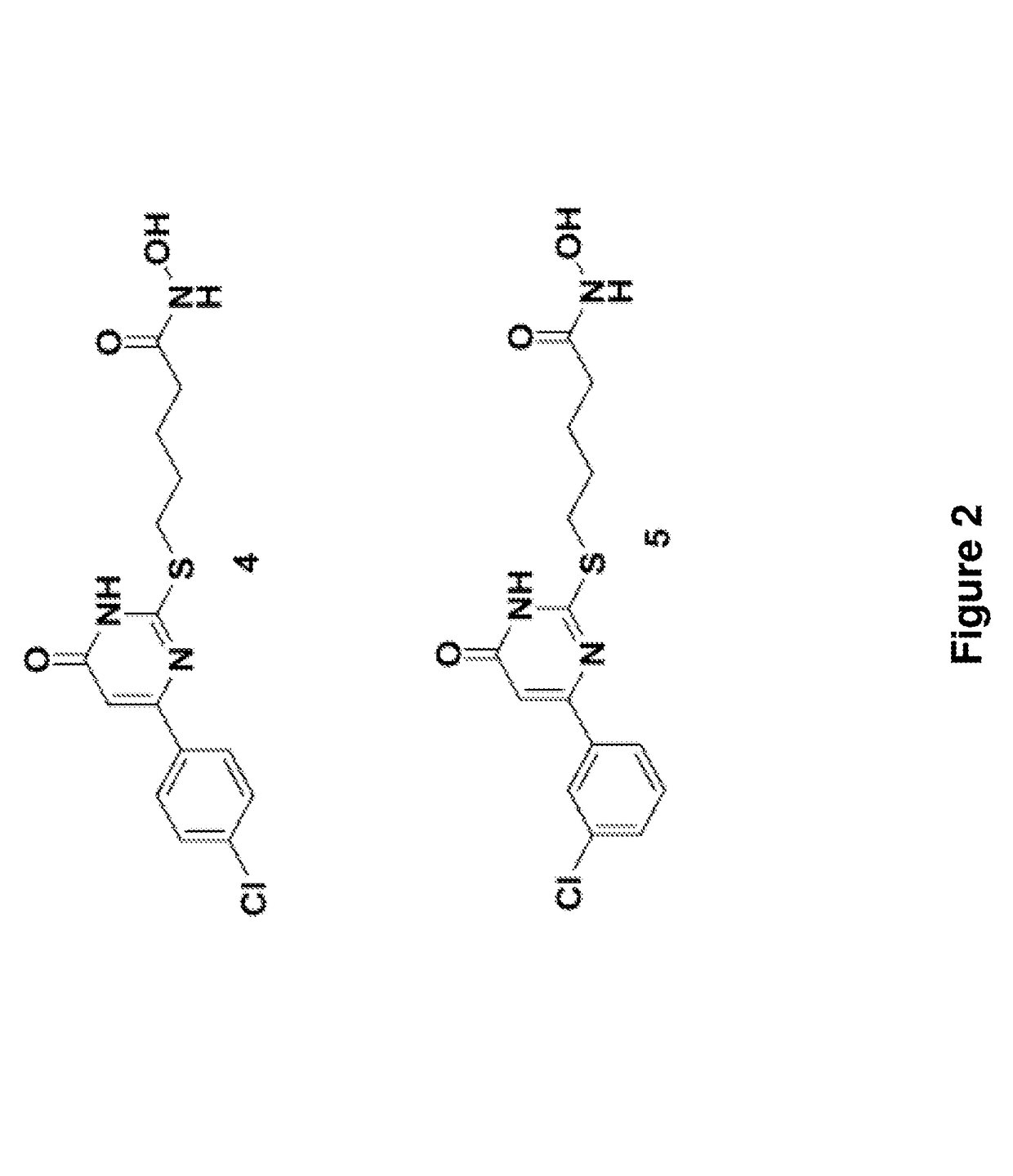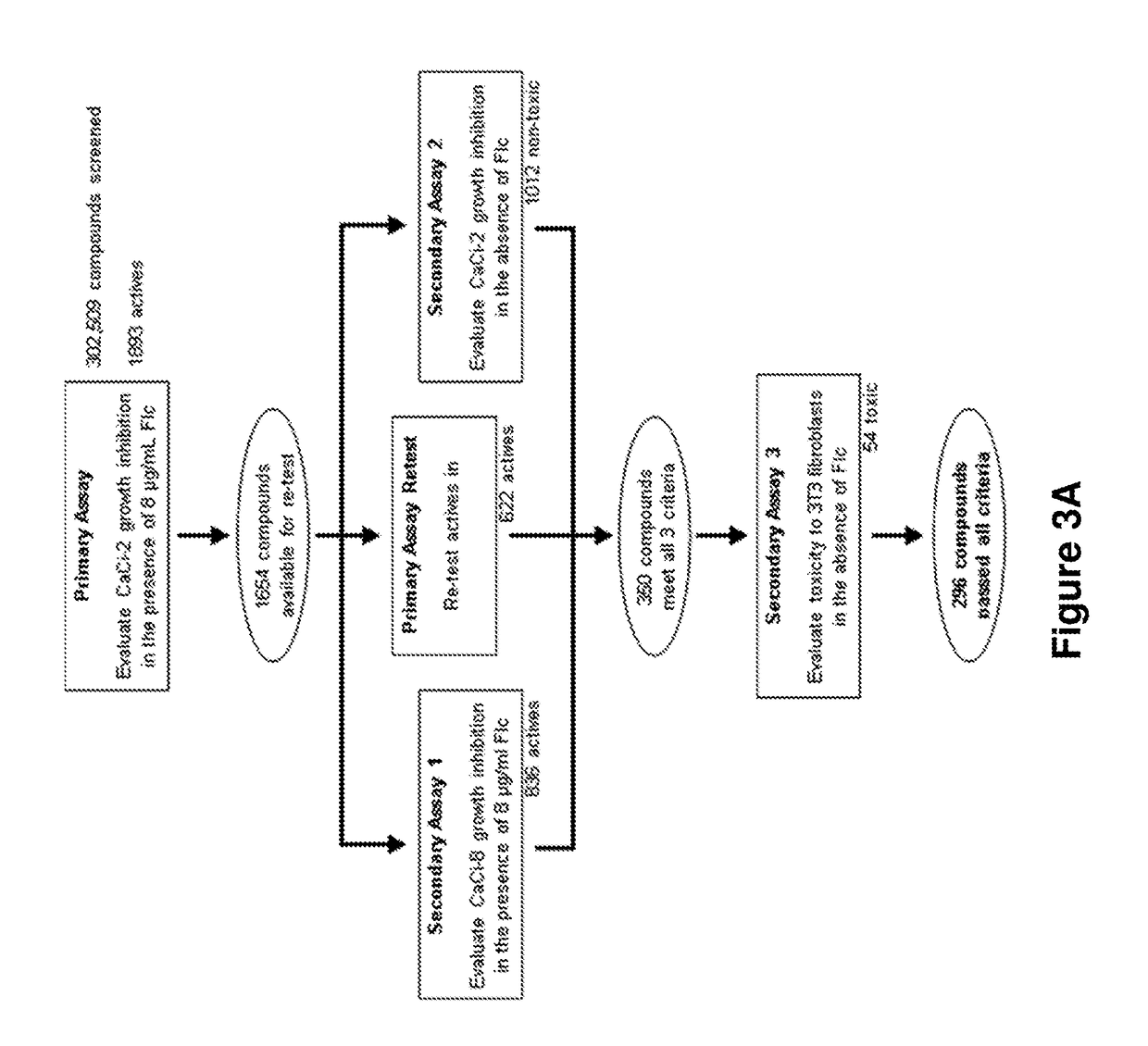Indazole derivatives and uses thereof
a technology of indazole and derivatives, applied in the field of antimicrobial agents, can solve the problems of reducing the potential of fungal-selective chemosensitizers, and achieve the effects of reducing or avoiding symptoms or causes, reducing or minimizing one or more symptoms, and reducing or minimizing symptoms
- Summary
- Abstract
- Description
- Claims
- Application Information
AI Technical Summary
Benefits of technology
Problems solved by technology
Method used
Image
Examples
example 1
of the Compounds
[0404]In order to identify non-fungitoxic chemosensitizers (“probes” or “probe compounds”) of C. albicans, compounds from the NIH's Molecular Libraries Small Molecule Repository (MLSMR) (mli.nih.gov / mli / secondary-menu / mlscn / ml-small-molecule-repository / ) were evaluated in the screening cascade summarized in FIG. 3. The C. albicans strains used in the primary screen and secondary assay 1 (CaCi-2 and CaCi-8, respectively) are both clinical isolates that partially respond to fluconazole treatment (Redding et al., Clin. Infect. Dis. 1994, 18, 240-242). The minimum inhibitory concentration (MIC) of fluconazole against CaCi-2 and CaCi-8 was determined to be 2 μg / mL and 8 μg / mL, respectively. In the primary assay, CaCi-2 cells are exposed to 8 μg / mL fluconazole; this induces a basal level of 60-80% growth inhibition with additional suppression of the trailing growth associated with this particular strain (Redding et al., Clin. Infect. Dis. 1994, 18, 240-242).
[0405]Desired a...
example 2
of the Compounds
[0412]Two different routes were adopted to access the various functionalized indazoles for the evaluation of the structure-activity relationships (SAR) of the compounds of the invention (Scheme 1). Suzuki-Miyaura reaction was selected for the preparation of analogs bearing substituents around the central indazole core. This approach also permitted rapid replacement of the phenyl ring at C3 with functionalized phenyl rings and alternative heterocycles. Preliminary attempts to couple substituted 3-iodoindazoles 4 directly failed to produce isolable amounts of desired product. Subsequently, the indazoles were protected as their tert-butyl carbamates (5) prior to undergoing palladium-mediated Suzuki reactions with various boronic acid partners. Under the reaction conditions, the carbamate protecting group was also cleaved to afford the desired 3-arylindazoles, albeit as the unprotected systems 6. Alkylation with methyl bromoacetate with potassium carbonate in hot acetone...
example 2.1
of tert-butyl 3-iodo-1H-indazole-1-carboxylate
[0422]
[0423]3-Iodo-1H-indazole (5.00 g, 19.5 mmol) was placed in a round-bottom flask and dissolved in tetrahydrofuran (100 ml). 4-Dimethylaminopyridine (0.24 g, 1.9 mmol, 0.1 equiv) was then added, followed by di-tert-butyl dicarbonate (5.4 ml, 24 mmol, 1.2 equiv). Triethylamine (5.4 ml, 39 mmol, 2.0 equiv) was slowly added to the clear brown solution by syringe. The resulting solution was stirred at room temperature and monitored by TLC until complete. The reaction required approximately 2 hours. Once complete, the reaction was diluted with water (75 ml) and ethyl acetate (50 ml). After separating the layers, the aqueous phase was extracted with additional ethyl acetate (3×50 ml). The combined organic layers were washed with brine (100 ml), shaken over magnesium sulfate, filtered, and concentrated under reduced pressure to give a dark red oil (8.40 g). The crude material was purified by column chromatography over silica gel (hexanes / et...
PUM
| Property | Measurement | Unit |
|---|---|---|
| diameter | aaaaa | aaaaa |
| diameter | aaaaa | aaaaa |
| diameter | aaaaa | aaaaa |
Abstract
Description
Claims
Application Information
 Login to View More
Login to View More - R&D
- Intellectual Property
- Life Sciences
- Materials
- Tech Scout
- Unparalleled Data Quality
- Higher Quality Content
- 60% Fewer Hallucinations
Browse by: Latest US Patents, China's latest patents, Technical Efficacy Thesaurus, Application Domain, Technology Topic, Popular Technical Reports.
© 2025 PatSnap. All rights reserved.Legal|Privacy policy|Modern Slavery Act Transparency Statement|Sitemap|About US| Contact US: help@patsnap.com



